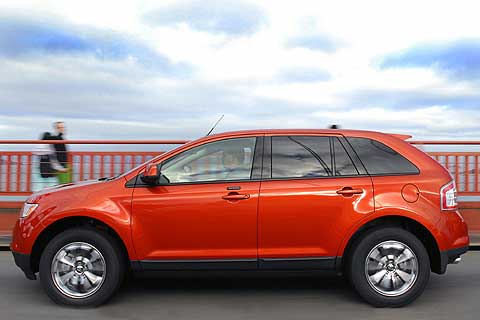SUVs Rank High On IIHS Safety Report, Small Cars Do Not
 According to the Insurance Institute for Highway Safety (IIHS), drivers of sport-utility vehicles are among the least likely to die in a crash and are far safer than those in small cars. The report, released on June 9, cited the Ford Edge SUV as having one of the lowest rates of driver deaths of 2005-2008 models.
According to the Insurance Institute for Highway Safety (IIHS), drivers of sport-utility vehicles are among the least likely to die in a crash and are far safer than those in small cars. The report, released on June 9, cited the Ford Edge SUV as having one of the lowest rates of driver deaths of 2005-2008 models.
The marked improvement in SUV safety is largely due to the installation of electronic stability control, says the IIHS. Stability control, which uses brakes and engine power to keep vehicles on the road, was introduced more quickly on SUVs.
The death rate for SUV drivers dropped sixty-six percent from eighty-two per million vehicles for 1999-2002 models to twenty-eight per million for 2005-2008 models.
But the news wasn't nearly as good for drivers of small cars, which have become more popular because of high gas prices.
The death rate for drivers of small, four-door cars was seventy-two per million vehicles for 2005-2008 models, down thirty-five percent from 110 per million in 1999-2002 models.
"The rollover risk in SUVs used to outweigh their size/weight advantage, but that's no longer the case," says Anne McCartt, the institute's Senior Vice President for Research.
"It's a dramatic change and a testament to the incredible effectiveness of electronic stability control," she says.
Wade Newton, spokesman for the Alliance of Automobile Manufacturers, says the IIHS report should raise "red flags" for regulators drafting new fuel-economy rules that will force automakers to sell smaller, lighter vehicles. A proposed standard is expected this fall.
Industry officials are worried the National Highway Traffic Safety Administration may also mandate costly new safety improvements to address concerns that smaller cars will lead to more deaths.
"For years, small cars have represented the low end of the economic spectrum and received fewer safety and enhanced design features," says Sean Kane of Safety Research & Strategies, which advises plaintiff lawyers, government and auto suppliers. "Undoubtedly, that has an effect."
The IIHS report also shows that drivers of small cars are almost three times more likely to die in a collision than in a rollover. That shows stability control is not likely to have as much of a beneficial effect.
Mukul Verma, a veteran auto industry safety official, says that suggests more focus is needed to improve the safety of small cars when they hit larger vehicles.
"The trend from the reported data is clear: The lighter the vehicle, the higher the likelihood that its driver will be killed in a collision with another vehicle," says Verma, now a consultant.
Also from the IIHS, the 2011 Saab 9-5 and 2011-12 Volkswagen CC earned Top Safety Pick ratings.
The Saab 9-5, a large luxury car, and the Volkswagen CC, a midsize luxury car, are Top Safety Pick award winners after earning good ratings for performance in the Institute's roof strength test for rollover protection. These cars earlier earned good ratings for front, side, and rear crash protection, and they have standard electronic stability control. Top Safety Pick only applies to the front-wheel drive CC because the heavier all-wheel drive version is rated acceptable in the roof strength test.
Altogether, the Institute recently completed roof strength tests for eight midsize to large family and luxury cars. Also earning a good rating for rollover protection is the 2011 Lexus ES 350, which is not a Top Safety Pick winner because it's rated marginal for rear crash protection. The BMW 3 series, Chevrolet Impala (models built after July 2010), Infiniti G, Lexus IS 250/350, and Saab 9-3 earn acceptable ratings for rollover protection.
To measure roof strength, a metal plate is pushed against one corner of a vehicle's roof at a constant speed. The maximum force sustained by the roof before 5 inches of crush is compared to the vehicle's weight to find the strength-to-weight ratio. This is a good assessment of vehicle structural protection in rollover crashes.
 According to the Insurance Institute for Highway Safety (IIHS), drivers of sport-utility vehicles are among the least likely to die in a crash and are far safer than those in small cars. The report, released on June 9, cited the Ford Edge SUV as having one of the lowest rates of driver deaths of 2005-2008 models.
According to the Insurance Institute for Highway Safety (IIHS), drivers of sport-utility vehicles are among the least likely to die in a crash and are far safer than those in small cars. The report, released on June 9, cited the Ford Edge SUV as having one of the lowest rates of driver deaths of 2005-2008 models.